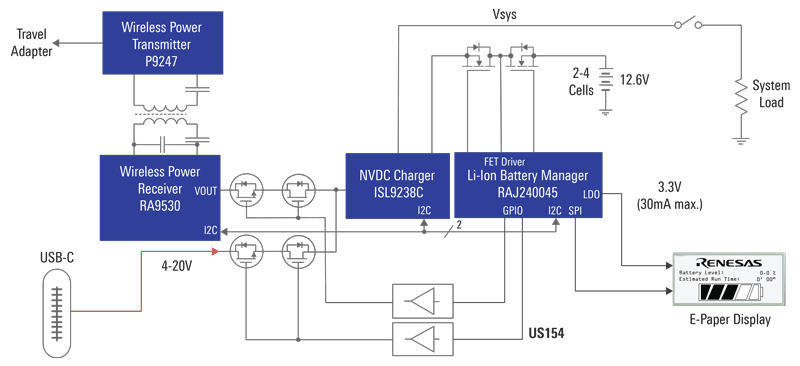A lot of times we take battery-operated devices for granted. We pick up a flashlight, turn it on and if it is dim or does not light, we grab some new batteries or plug it back into its charger. What if something critical was dependent on the operation of a battery-operated device? A firefighter picks up his flashlight, it had better work and for a predetermined length of time. In the "heat of the moment", no fumbling for buttons to light LEDs, just the battery status "visible at a glance". More importantly, in the instance where a life may depend on the equipment operating. What if he grabs his AED and runs 100 yards to a patient, only to find the charger was not connected and the battery was weak?
The Battery Management with Life Indicator winning combination is a reference design (see Figure 1). This Battery management system (BMS) combines an RAJ240045 Li-ion battery management device with ISL9238C DC/DC charger control. We complete this by adding a low power e-paper display and selectable power source using either a wireless charging system or a USB-C (charge only) connection.

The design revolves around the RAJ240045 which is an intelligent battery management device based on the RL78 low power MCU core. The battery algorithm can handle from 2 to 4 Li-ion cells while the MCU still has the ability to control other subsystems. It allows the various sub-systems of this design to be programmed or controlled over the I2C bus of the MCU, such as the NVDC charger or the wireless receiver.
The ISL9238C NVDC charger supports from 2 to 4 cells, making it a perfect match for the RAJ240045. It can support a wide input voltage range of 3.9VDC to 23.4VDC, so it can use direct charging power from a USB-C connector. This allows you to jack it into a USB-C connector for in-the-field charging.
The other power source is the wireless charging system based on the RA9530 wireless power receiver. The receiver is Qi compatible so it can actually be used with almost any wireless power transmitter. We do show the complete solution utilizing the P9247 wireless power transmitter. This allows you to "customize" the full solution by making a system-specific charging cradle for a high-reliability situation or an odd-shaped device.
Finally, the battery state indicator is an e-paper display that only requires updating or draws power when the display is changed. It is controlled by an SPI bus on the MCU. Since the battery manager is based on an RL78 low-power MCU, it can stay in its lowest power mode and wake up based on the system design requirements doing a periodic update of the display for accurate battery status for the user. For example, suppose the unit that depends on the battery draws some "vampire power" even when not in use. An example of this might be keeping an RTC running and/or supporting wake-up logic. The BMS can take this into account and wake up at a predefined periodic rate (to keep its battery draw to a minimum), establish the battery's status and update the display providing an "I am ready to do my job" message to the end user. If not in use, it can also display a "charger not connected" message to make the BMS even more reliable.
This winning combination provides a reliable design for Li-ion battery management with battery status visibility "at a glance". For more information on this and other winning combinations visit the winning combinations page, www.renesas.com/win to see more solutions that can be used to help accelerate your designs to get to market faster.
